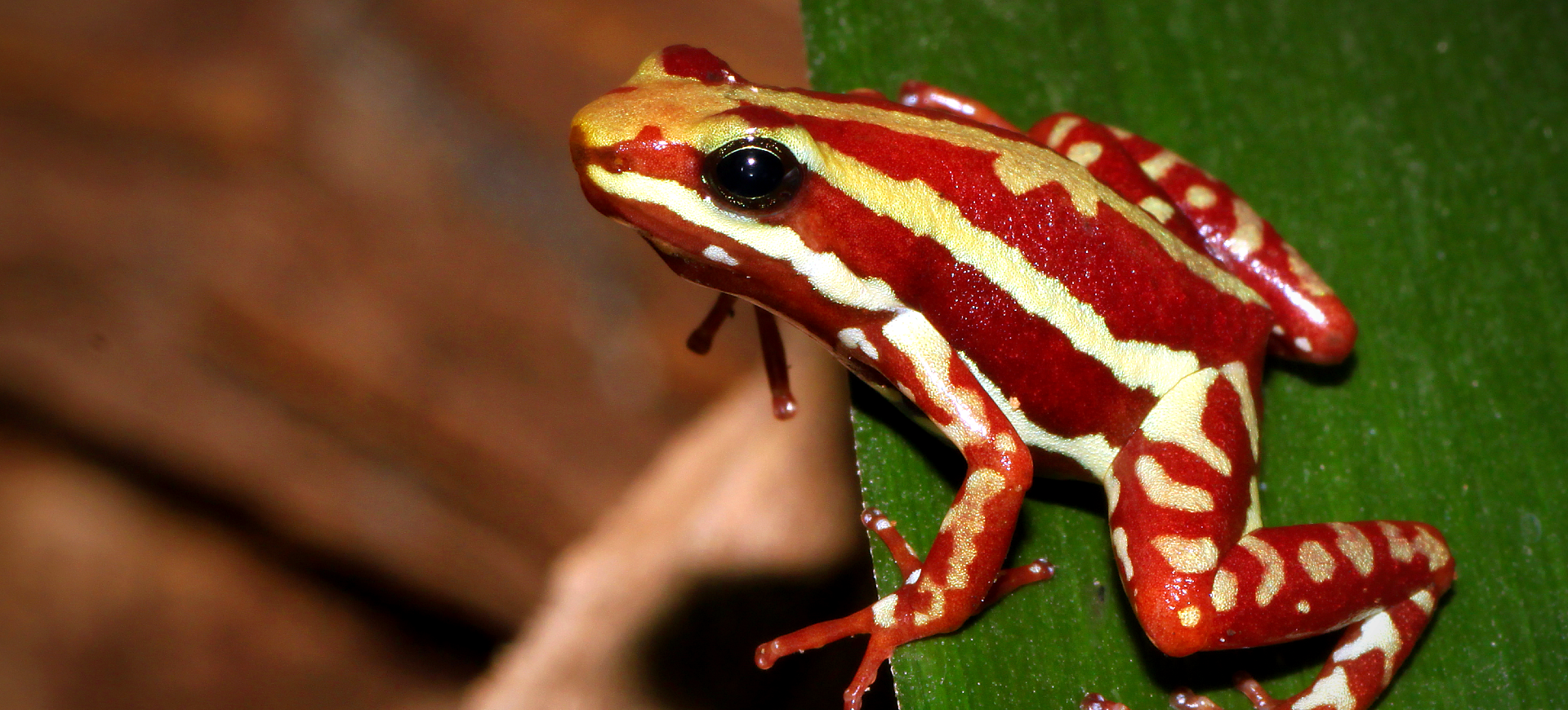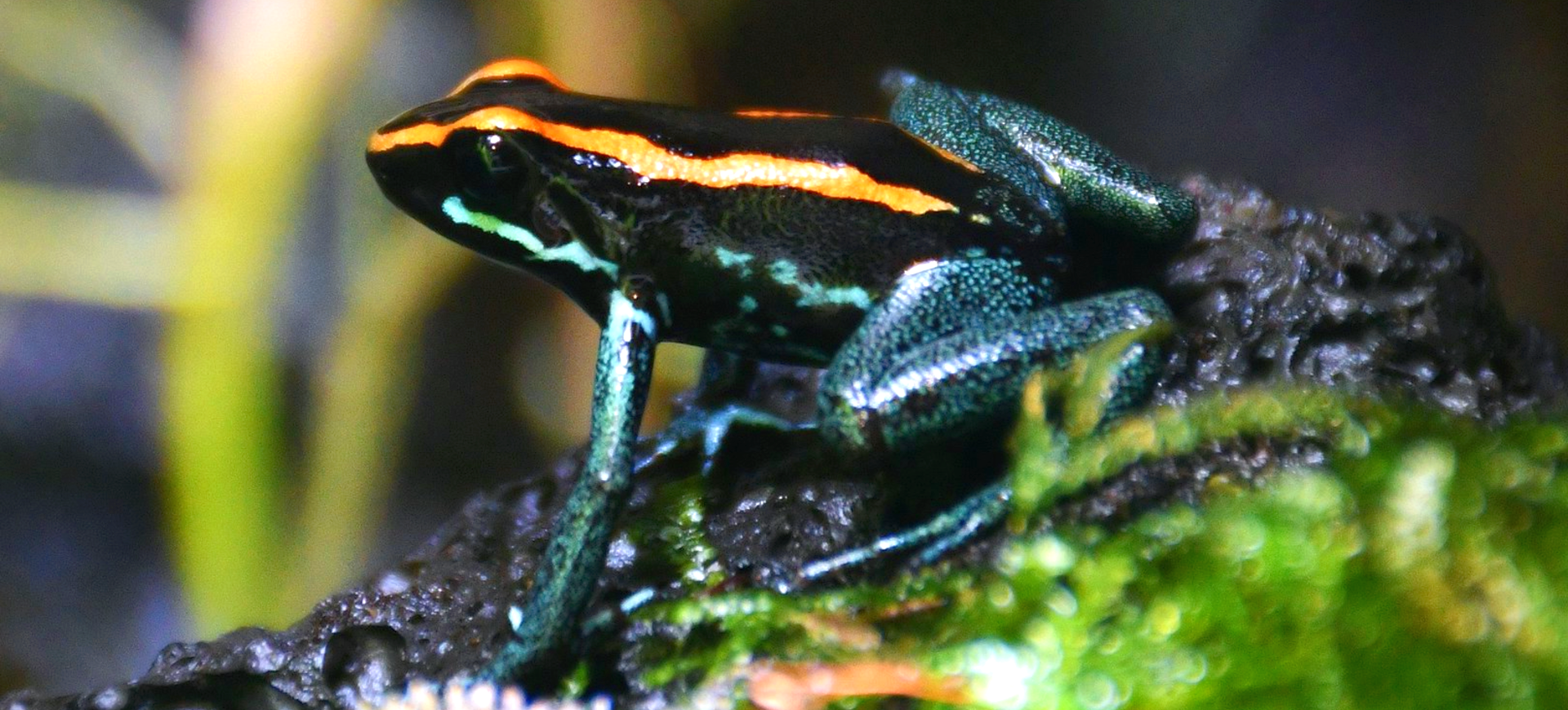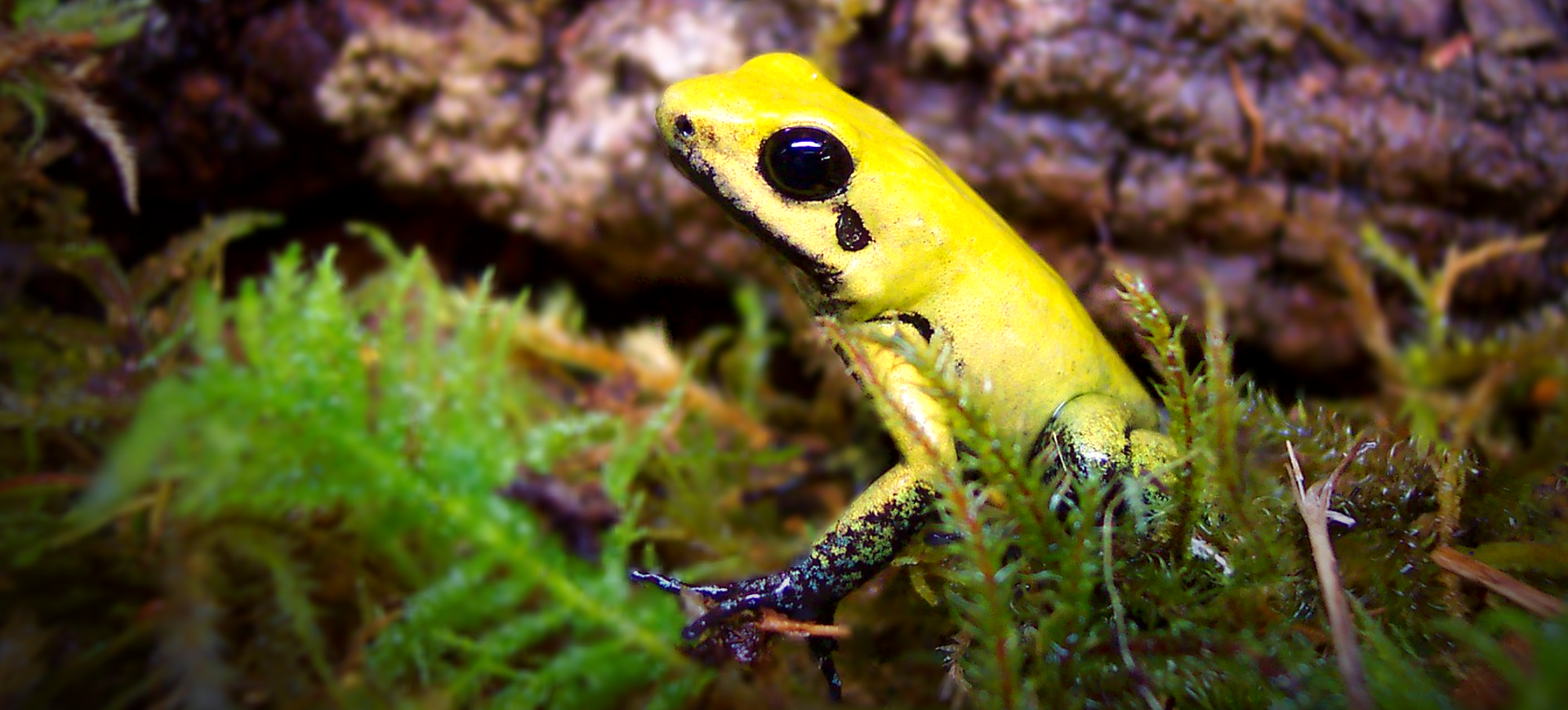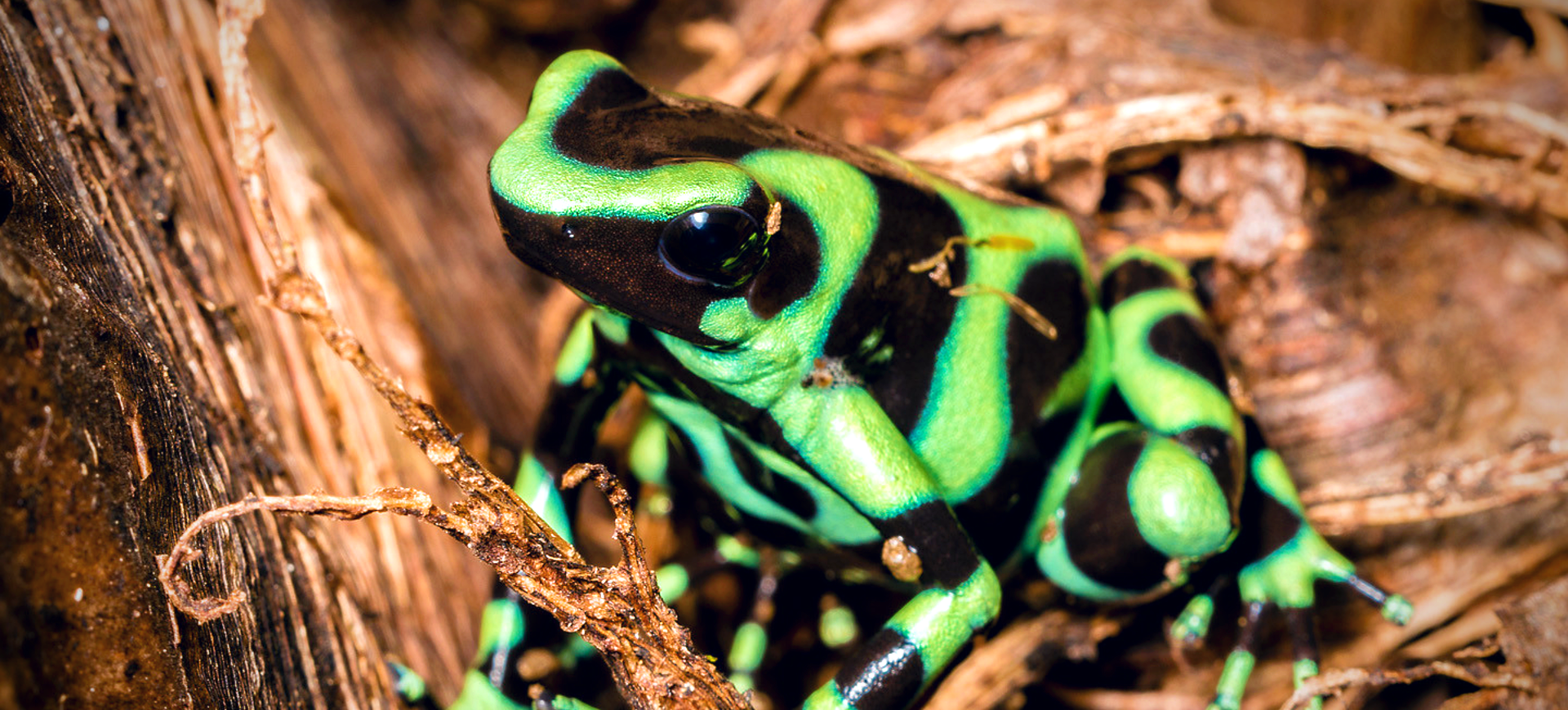Overview
The Yellow-banded Poison Dart Frog (Dendrobates leucomelas), also known as the Bumblebee Poison Frog, is a strikingly colored amphibian native to parts of South America. Characterized by its vibrant yellow and black-banded pattern, this small frog has gained significant attention for its beauty and toxic skin secretions. Typically found in humid environments, these frogs are active during the day and are known for their loud, trilling calls.
Yellow-banded Poison Dart Frogs are relatively small, averaging about 1.5 inches long. They are part of the Dendrobatidae family, renowned for the toxic substances found in their skin, which is a defense mechanism against predators. These toxins are derived from their diet in the wild, primarily consisting of ants and other small insects. In captivity, where their diet changes, they lose their toxicity.
This species exhibits a fascinating reproductive behavior, where males primarily guard the eggs. After hatching, one of the parents (usually the male) carries the tadpoles to small pools of water, such as bromeliad axils, where they continue their development. The Yellow-banded Poison Dart Frog is an example of an amphibian that has adapted well to its environment, with its coloration and behavior serving as key survival mechanisms.
Taxonomy
Kingdom
Phylum
Class
Order
Family
Genus
Species
Type
Physical Description:
The Yellow-banded Poison Dart Frog is renowned for its vibrant coloration, a mix of bright yellow and deep black bands, warning potential predators about its toxicity. Each frog has a unique pattern, although all share the characteristic yellow and black color scheme. The skin of these frogs is smooth and glossy, which enhances the visual impact of their coloration.
In terms of size, they are small and compact, with females being slightly larger than males. Their legs are strong and well-adapted for jumping, a common trait among frogs. Their toes are equipped with adhesive pads, enabling them to climb and cling to various surfaces. The bright coloration of these frogs is not just for defense; it also plays a role in communication and mating.

Lifespan: Wild: ~5 Years || Captivity: ~20 Years

Weight: Male & Female: 0.07-0.1 oz (2-3 g)

Length: Male & Female: 1.2-2.0 inches (3-5 cm)
Characteristic:
Native Habitat:
The Yellow-banded Poison Dart Frog is native to the northern part of South America. Their habitat includes parts of Venezuela, Guyana, Brazil, and Colombia. They thrive in warm, humid environments, typically found in tropical rainforests.
Their preferred habitats are near small streams or wet areas in the forest, where humidity is high. These frogs are often found in leaf litter on the forest floor, under stones, or among fallen logs. They require a habitat with ample hiding spots and a steady supply of small insects for food.
Climate Zones:
Biomes:
WWF Biomes:
Biogeographical Realms:
Continents:
Diet:
Diet & Feeding Habits:
Yellow-banded Poison Dart Frogs are insectivores, feeding primarily on small insects and arthropods. Ants, along with termites, beetles, and other small invertebrates, form a significant part of their diet. The alkaloids found in the ants are believed to contribute to the frog’s toxicity.
These frogs use their long, sticky tongues to capture prey. They are active hunters, typically foraging during the day. Their hunting strategy involves patiently waiting and quickly lunging at prey that comes within range. In captivity, their diet consists of fruit flies, small crickets, and other commercially available small insects, which results in the loss of their skin’s toxic properties.
Mating Behavior:
Mating Description:
The mating behavior of the Yellow-banded Poison Dart Frog is unique. Males are territorial and attract females with their distinctive calls, which are louder and more frequent during the breeding season. Once a female is attracted, the male leads her to a suitable site for egg laying, usually a moist area or a leaf litter.
Females lay a small clutch of eggs, which the male then guards. The male is responsible for keeping the eggs moist, often by urinating on them to prevent desiccation. After the eggs hatch, the tadpoles are carried on a parent’s back (usually the male) to a water source, such as a bromeliad axil or a small pool. The parent frog ensures that each tadpole is placed separately, reducing resource competition.
Reproduction Season:
Birth Type:
Pregnancy Duration:
Female Name:
Male Name:
Baby Name:
Social Structure Description:
Yellow-banded Poison Dart Frogs have a semi-territorial social structure. Males establish and defend territories, which are used primarily for mating purposes. These territories are marked by the male’s call, which attracts females and deter rival males.
During the breeding season, their social interactions become more pronounced, with males actively competing for females. They are less territorial and may be seen in small groups outside of the breeding season. Environmental conditions, such as food availability and breeding sites, influence their social behavior.
Groups:
Conservation Status:
Population Trend:
The Yellow-banded Poison Dart Frog’s population is currently considered stable, particularly in areas where their habitat is protected. They are less threatened than some other poison dart frog species, partly due to their occurrence in several protected areas. However, ongoing habitat destruction and illegal pet trade could pose future threats.
Conservation efforts have been effective in maintaining stable populations in the wild. Educational programs and regulations in the pet trade have also helped reduce the impact of human activities on their natural populations. Research and monitoring continue to ensure that any potential threats are addressed promptly.
Population Threats:
The primary threats to the Yellow-banded Poison Dart Frog include habitat loss and degradation due to deforestation and agricultural expansion. Pollution and changes in land use also pose significant risks to their habitat. The illegal pet trade is another threat, although less significant than habitat destruction.
Climate change could impact their habitat, altering the humidity and temperature conditions these frogs require. Diseases, particularly those affecting amphibians like the chytrid fungus, also pose a risk. Conservation efforts aim to mitigate these threats through habitat protection and regulation of the pet trade.
Conservation Efforts:
Conservation strategies for the Yellow-banded Poison Dart Frog include habitat protection and regulation of the pet trade. Several of their native habitats fall within protected areas, which helps in maintaining stable populations. Captive breeding programs, both for conservation and the pet trade, have successfully reduced the need for wild-caught individuals.
Education and awareness campaigns are essential in highlighting the importance of these frogs and their ecosystems. Research into their ecology and behavior aids in understanding their needs and how best to protect them. International collaboration is also crucial, as these frogs are found in multiple countries within South America.
Additional Resources:
Fun Facts
- The Yellow-banded Poison Dart Frog’s bright coloration is a classic example of aposematism, where dangerous animals display vivid colors to warn predators.
- They have a relatively long lifespan for a small frog, living up to 10 years in the wild.
- They are popular pets in captivity due to their striking appearance and interesting behaviors.
- These frogs are excellent climbers, using their adhesive toe pads to scale vertical surfaces.
- The toxins in their skin are potent enough to deter most predators, but they are not dangerous to humans unless ingested or if they enter open wounds.
- Their calls can be heard considerably, especially during mating season.
- The Yellow-banded Poison Dart Frog is an important indicator species, reflecting the health of their ecosystems.
- They are diurnal, which is relatively unusual for amphibians, as most species are nocturnal.
- Despite their name, poison dart frogs are not used to make poison darts in their native range; this practice is associated with other species of poison dart frogs.
- These frogs exhibit a high degree of parental care, with males often playing a significant role in the survival of the offspring.












